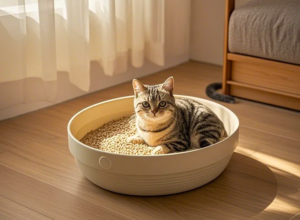Selecting the right cat litter box is key to keeping your cat comfortable and your home clean. With so many options available, it’s important to understand what makes a good litter box. Below are six critical factors to consider when choosing the ideal litter box.

1. Size and Shape of the Cat Litter Box
The size of the box is essential for your cat’s comfort. Experts recommend the box should be at least 1.5 times your cat’s body length (from nose to tail). For example, a cat that is 18 inches long will need a box that is at least 27 inches long. Standard boxes are around 18 x 14 inches, but for larger or multi-cat homes, opt for 22 x 18 inches or more.
Shape is another consideration. Corner boxes are great for saving space in small homes, but they may not offer enough room for larger cats. Rectangular boxes are generally the most versatile.
2. Entrance and Exit Design
Ease of entry is crucial, especially for kittens or older cats. Low-sided boxes are easier to access, while high-sided or hooded boxes help contain litter that may spill out during use.
For multi-cat households, it’s ideal to have at least one litter box per cat, plus one extra. For example, three cats should have four boxes to avoid territorial disputes and ensure each cat has access to a clean box. Some models even have multiple entrances, making them more accessible to all cats.
3. Material and Durability
Litter boxes are usually made from plastic, which is durable and easy to clean. Look for high-quality plastic (e.g., polypropylene or ABS), which resists scratching and odor. Eco-friendly options, such as bamboo or recycled paper, are available but may require more maintenance.
Stainless steel boxes are the most durable and long-lasting, sometimes lasting up to 10 years, but they are heavier and more expensive.
4. Antibacterial and Odor Control Features
Controlling odors is crucial for both you and your cat. Hooded boxes or boxes with antibacterial coatings help reduce odors and bacteria. It is recommended to clean the litter box at least once a day and change the litter every one to two weeks.
Using odor-absorbing litter, such as clumping clay or silica gel, can also help keep the box fresh. Some boxes come with built-in deodorizing systems, making odor control easier.
5. Ease of Cleaning
To maintain hygiene, a litter box should be easy to clean. Smooth, non-porous surfaces prevent litter from sticking, and removable trays or liners can simplify the cleaning process. Self-cleaning litter boxes are convenient but expensive, typically ranging from $100 to $500.
Tip: Opt for a box with rounded corners to reduce litter build-up and make cleaning faster.
6. Multi-Cat Households
For homes with multiple cats, it’s recommended to have one litter box per cat, plus one extra. If you have three cats, offer four boxes to reduce territorial conflicts. A larger box (at least 22 x 18 inches) or one with dual chambers can help handle the increased waste.
Self-cleaning litter boxes with larger capacities are ideal for multi-cat homes, as they can handle more waste and reduce maintenance time.
Conclusion
Choosing the right cat litter box involves considering size, material, odor control, ease of cleaning, and suitability for multi-cat homes. Whether you choose a basic box or an advanced self-cleaning model, focusing on these six factors will help you select a litter box that meets and satisfies your cat’s needs, keeps your home clean, and keeps your cat happy.
